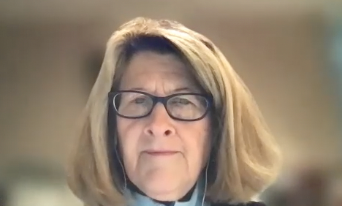Sandra Day O’Connor blazed a trail that took her from a Texas cattle ranch to the nation’s highest court by navigating a work world rife with gender discrimination while wielding her own brand of feminism.
O’Connor, who died Friday morning at the age of 93, overcame snubs from Big Law firms that preferred that the Stanford Law School graduate take a job as a secretary.
As an Arizona state senator, she faced off with often chauvinist male colleagues on the way to amending hundreds of gender-biased laws, and became the first woman ever to lead a US legislative chamber.
And while serving as the first female US Supreme Court justice, she cast the swing vote in the case that upheld legal abortion, actively promoted young female lawyers, and created a path for women to serve in top legal industry positions.
But O’Connor’s legacy on women’s rights remains complicated and often overshadowed by other barrier-busting women, including feminist icon and fellow justice Ruth Bader Ginsburg.
“She might not have called herself a feminist, but she did things that at the time women shouldn’t do,” said Ruth McGregor, former chief justice on the Arizona Supreme Court, who clerked for O’Connor in 1981, the year she joined the US high court. “She believed women should do anything they’re qualified to do. She wanted to make sure women are on the same legal footing as men, and old stereotypes get pushed aside.”
Her unique career makes it difficult to slap a simple, straightforward label that puts her “in a box” or defines her as a feminist, said Wendy Parmet, a Northeastern University law professor, who co-authored a 1999 Indiana Law Review study of O’Connor’s legacy on women’s rights issues.
“Feminist lawyering is not a category where you get a membership card,” Parmet said. “She was an important figure for women in the law and we see that in her body of work.”
Court Decisions
O’Connor could neglect the real experiences of women and communities of color because of her individualistic self-identity and fact-based approach as a justice, Parmet and her co-authors argued in the law review article.
“Rugged feminism is the feminism of a woman who doesn’t want to see herself as dependent and doesn’t have to,” Parmet said in an interview. “She was financially privileged by her whiteness and class and status her whole life.”
Although O’Connor seemed to recognize the power dynamics affecting “issues of relatively well-heeled white women,” she failed to see them when dealing with issues tied to the “economic disadvantages created by structural racism,” Parmet said.
O’Connor’s approach to Planned Parenthood v. Casey—one of her most important contributions to constitutional law—illustrates that blind spot for systemic drivers of inequality. O’Connor voted to strike the portion of a Pennsylvania law that limited abortion rights, including a requirement for a woman to get her husband’s permission. But she rejected the argument that another provision of the law, a 24-hour waiting period, was an undue burden despite its significant impact on poor women and single mothers.
Yet O’Connor staked positions that advanced women’s rights starting soon after she joined the Supreme Court. She wrote the court’s 1982 ruling in Mississippi University for Women v. Hogan that set the legal test for courts to analyze the constitutionality of government policies that discriminate between genders.
Near the end of her tenure on the bench, O’Connor dissented in a case involving a mother who was pulled over while driving her two small children home from soccer practice solely because they weren’t wearing seat belts. The mother, who was handcuffed and taken to jail, sued for false arrest and violation of her constitutional rights.
The majority’s 2001 ruling in Atwater v. Lago Vista, held that the mother had no case. But O’Connor joined the liberal justices and filed an impassioned dissent that noted how traumatizing the event was for a three-year-old.
“Women are either seen as furthering the cause for feminism or against it, just by virtue of being a woman in the political world,” said Abigail Perkiss, a Kean University associate history professor, who studied O’Connor’s career as a justice.
O’Connor was a moderate conservative who embraced her role as a moderating force on the Supreme Court, Perkiss said.
Early Hurdles
O’Connor bristled at attempts to define her as a feminist, which was derided in the conservative circles she rose through in the 1960s as a label for a bra-burning radical.
“I come to you with my bra and my wedding ring on,” she once told a rotary club meeting, according to Evan Thomas’ 2019 biography, First: Sandra Day O’Connor.
Yet O’Connor faced discrimination throughout her career. She had difficulty landing a law firm job, even as a Stanford Law graduate in the top 10% of her class. Gibson, Dunn & Crutcher LLP, which had never hired a woman lawyer, rejected her after the partner she interviewed with suggested she might be able to get a job as a legal secretary at the firm.
She eventually worked for free at the San Mateo County, Calif., district attorney’s office. She still couldn’t get a job at an established firm in Phoenix a dozen years after earning her law degree, at one point opening her own practice in a shopping center.
O’Connor stopped practicing law for five years while her three children were young, but was active in the Arizona Republican Party and Sen. Barry Goldwater’s (R) 1964 presidential campaign. She eventually launched a career as a state lawmaker before moving to the bench.
O’Connor served as an Arizona state trial court judge and was elevated in 1979 to fill an empty state appellate court seat, which was vacant after President Jimmy Carter nominated Mary Schroeder to the US Court of Appeals for the Ninth Circuit.
O’Connor got her presidential appointment two years later, when President Ronald Reagan tapped her to join the Supreme Court.
She took her role as the first female justice seriously, ushering in and inspiring generations of women who came after her, said Scott Bales, a former state Supreme Court chief justice, who clerked for O’Connor from 1984 to 1985.
“Being the first woman on the Supreme Court had a lot of impact, even in small ways,” he said. “Someone needed to break the ceiling and she was a remarkably well-suited person to do it.”
One small impact O’Connor had was on the brass nameplates attached to the justices’ office doors. Before she was confirmed to the court, the nameplates said “Mr. Justice” and there was a whole discussion before she arrived about whether O’Connor’s should say “Mrs. Justice O’Connor” or “Ms. Justice Connor,” said Deborah Jones Merritt, who clerked for O’Connor in her first term.
“They finally decided to take all the plaques down and just simply say ‘Justice O’Connor’ and ‘Justice Blackmun,’” she said. “It was like this is a new world for everybody in the Supreme Court. They were trying to figure out how will having a woman here affect things.”
There also wasn’t a women’s bathroom near the justice’s conference room at the time she joined the court, Lisa Monet Wayne, executive director of the National Association of Criminal Defense Lawyers, noted in a statement Friday which said O’Connor had “paved the way for countless women and people of color to follow in her footsteps.”
Evolving Court
O’Connor only served alongside one other woman justice, Ginsburg. But four other women, all of whom are currently serving on the high court, have since been appointed, and each is a first in her own right.
Sonia Sotomayor, appointed by Barack Obama in 2009, was the first woman of color to be a justice. Ketanji Brown Jackson — President Joe Biden’s appointee — is the first Black woman justice, and Elena Kagan was the first woman to serve as solicitor general before she was nominated to the high court. Amy Coney Barrett, Donald Trump’s third appointed justice, is the first woman to have school-age children while serving on the Supreme Court.
The women also represent a range of ideologies, with Sotomayor, Kagan, and Jackson comprising the court’s liberal wing while Barrett is part of the conservative majority.
Melissa Murray, a New York University School of Law professor, said that when O’Connor was nominated, there were not many women judges who both fit the Reagan administration’s conservative requirements and were qualified to sit on the Supreme Court.
“Now on both sides of the aisle, the idea that you would not nominate women, that you’d not have a bench that had serious gender diversity, I think is perhaps less of a view,” Murray said.
—With assistance from Erin Mulvaney, Jacqueline Thomsen, and Lydia Wheeler




